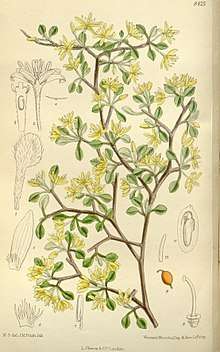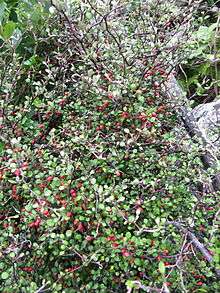Corokia cotoneaster
Corokia cotoneaster is a flowering plant in the family Argophyllaceae. Which was described by Étienne Fiacre Louis Raoul in 1846. Usually, this plant is known by the name wire-netting bush, korokio / korokia-tarango. The word "Koriko" comes from the Māori language.
| Corokia cotoneaster | |
|---|---|
 | |
| Scientific classification | |
| Kingdom: | Plantae |
| Clade: | Tracheophytes |
| Clade: | Angiosperms |
| Clade: | Eudicots |
| Clade: | Asterids |
| Order: | Asterales |
| Family: | Argophyllaceae |
| Genus: | Corokia |
| Species: | C. cotoneaster |
| Binomial name | |
| Corokia cotoneaster Raoul (1846) | |
Identifications
Corokia cotoneaster is a highly branched shrub with a strongly divaricating habit with rough dark-colored bark, usually growing to about 3 m in height. Common variable shrubs with thin gray zig-zag twigs that contain small white clusters underneath with dented or rounded edges and on flat, black petioles. Yellow flowers, star-shaped and red fruits. The leaves are variable, depending on altitude and to the degree of exposure to wind, and are obvo-cuneate to obovate-oblong, 2–15 cm long and 1–10 cm wide. The leaves of juveniles are long and spathulate with 3 lobes. Flowers are borne in leaf axils or terminally in groups of 2 to 4 flowers with bright yellow petals. The main flowering season is December to January.
Geographic distribution and habitat
Global range
Corokia cotoneaster is a native and endemic plant in New Zealand. Related species can be found on several small islands around the Pacific Islands .
New Zealand range
Corokia cotoneaster is most commonly found throughout the North and South Islands in New Zealand .
Habitat preference
Corokia cotoneaster prefers to survive in areas that are not wet. This plant likes to grow and develop in dry, rocky, and dense soils. Therefore, this species is very fertile in dry areas such as in the hills, rocky mountains, and in dry land.
Life cycle
The fleshy drupe is spread by frugivory, where the spread of plant growth is caused by animals such as lizards and birds that help regenerate Korokia with seeds that fall to the ground. It has spring blooms of small fragrant yellow flowers followed by red berries in autumn and with round ripe fruits that turn bright red or yellow in late summer. Also, this plant can be the focal point of every garden and research shows that the abundance of divaricate bushes can be a mechanism to avoid photosynthesis when carrying out photosynthesis under certain winter conditions. This branched architecture provides protection for the leaves of green plants in bright sunlight during winter. This plant gets better with age and can be admired throughout the year. Korokia flowers must bloom from April to May.
Ecology
Edaphic factors
Most of the Canterbury plains consist of dry shallow soils, very vulnerable to drought during the summer months. These include shallow Waimakariri land and also rocky and shallow Chertsey, Lismore, and Eyre soils. However, there are a number of strong native plants that have adapted to these conditions and the community plays an important role in conditioning the soil. This process creates a friendlier environment for less strong native species and eventually giant podocarp like Korokia. The seasonal climate makes dry and windy summer, cold, and humid winter. Land generally has low natural fertility. Also, various habitats in hilly areas, steep cliffs along incised rivers, and old river terraces.
Predators, parasites and diseases
Korokia can be a food source on the site in terms of fruit trees, flowering, and nurseries. The thickness of leaf litter is also a factor for lizards who like to eat insects. Corone cotoneaster fruit is usually removed at the latest, with many plants producing large numbers of ripe fruit in late fall. Fruits have large, hard endocarp-covered seeds that are covered by a very thin fruit pulp, which offers relatively few gifts for frugivores. However, fruits (especially cotoneaster in mid-Canterbury) are abundant in the diets of many extinct herbivorous moa species. Hard endocarp seeds are common in species that are known to have been eaten by moa (eg Cyathodes, Leucopogon, Myrsine, and Corokia), so it is possible (though not tested) that slow cotoneaster release is the result of moa extinction. This plant has problems with very few pests. Berries are favored by birds so protection may be needed in the fall. The only other damage suffered by Corokia caused by crickets. These insects lay eggs in the branches of this plant so to do this they cut the clump with a triangle mark into the bark. You can find a lot of this damage towards the end of the summer especially if you live in or near the bush. Although this is not fatal to this plant, it weakens the branches and creates unsightly scars.
Other information
Korokia's advantages for landscapes
Corokia cotoneaster is said to be a useful and versatile plant because this plant has its own advantages. For example, this plant is useful for landscapes such as a barrier in the park that can even withstand anger from the worst strong winds. Therefore, this plant will remain compact and maintain a good shape. Cutting from time to time will greatly improve their appearance. They also respond well to strong clippings which make them ideal shrubs to be shaped or hedged. They form an attractive and beautiful fence, from very low to medium altitude. Dense small leaves mean the fence will remain tight and compact and has a beautiful color. Also, Corokia cotoneaster has the appearance of many red, orange, and yellow fruits so that variations in the color of the berries possible in one population are quite extraordinary. Corokia cotoneaster colour changes are muted in sub-alpine landscape.
The benefits of Korokia for ecology
While another advantage of Korokia which is undoubtedly is to fulfill an important ecological function in providing food for native lizards. In addition, flowers are abundant and help the environment by feeding bees, birds, and also these plants can be a place to live for other animals such as insects and others.
The use of Korokia in Maori culture
Corokia cotoneaster plays a role in New Zealand's cultural sector and the medical sector. In the Māori tradition, korokio or karamū leaves are used in ceremonies to remove tapu from food. Hardwood from its intertwined branches is made into fish hooks and also made into knives to pierce the skin in treating wounds or wounds of war. Ngai Tahu uses the delicate branches of corchio as a hole when making fire (hika or hinga), using polished wood (Kauati) from Kaikōmako or Tōtara on a grooved base (Kaueti) like softwood. And also unique, in healing and Māori herbs, some shrubs of this species have medicinal value as a tonic. Chorea leaves are boiled and when cooled, the liquid is drunk as a treatment for stomach complaints and ulcers, which according to some sources provide instant relief. Also, the Maori make wooden knives from the branches of this plant and use them to pierce the skin when needed to treat battle wounds, unintentional injuries
Gallery
References
| Wikimedia Commons has media related to Corokia cotoneaster. |
- New Zealand Plant Conservation Network. (2020). Corokia cotoneaster. Retrieved from https://www.nzpcn.org.nz/flora/species/corokia-cotoneaster/
- Fisher, M. E., & Forde, M. L.(1994). Growing New Zealand Plants, Shrubs & Trees (pp. 35). New Zealand: David Bateman Ltd.
- Howell, C. J., Turnbull, D. K., & Turnbull, M. H. (2002). Moa Ghosts Exorcised? New Zealand’s Divaricate Shrubs Avoid Photoinhibition. Functional Ecology, 16(2), pp. 232-240.
- Young, L. M., & Kelly, D. (2014, April 9). Current rates of fruit removal and seed dispersal in New Zealand fleshy-fruited mountain plants. New Zealand Journal of Ecology, 38(2)
- Smith-Dodsworth, J. C. (1991). New Zealand Native Shrubs and Climbers (pp.29). New Zealand: David Bateman Ltd.
- Gibson, R. (2020). Guide to Keeping New Zealand Lizards in Captivity. Retrieved from https://www.doc.govt.nz/Documents/about-doc/concessions-and-permits/protected- wildlife-in-captivity/best-practice-guide-keeping-lizards-in-captivity.pdf
- MacFarlane, A. E. T., Kelly, D., & Briskie, J. V. (2015, December 7).Introduced blackbirds and song thrushes: useful substitutes for lost mid-sized native frugivores, or weed vectors?. New Zealand Journal of Ecology, 40(1). doi: 10.20417/nzjecol.40.9
- Riley, M. (1985). Shrubs & Small Trees (pp. 28). New Zealand: Viking Sevenseas Ltd.




